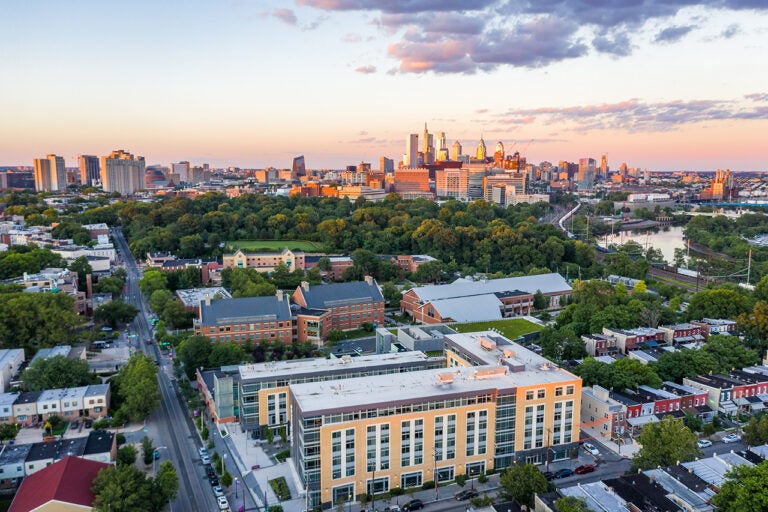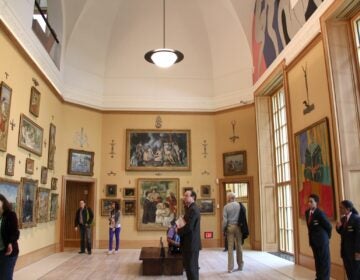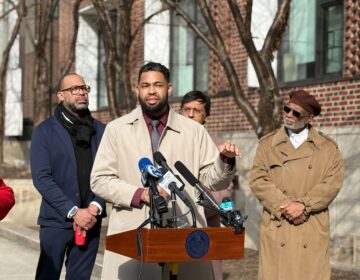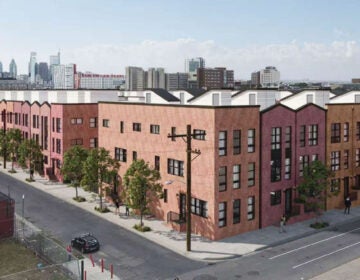Without interest from Penn, St. Joe’s nears sale of first properties on USciences campus
Developments have been proposed for three outlier sites. But some speculate that one of Philly’s “eds and meds” heavyweights could still enter the mix.

Saint Joseph’s University in University City, Philadelphia (Courtesy St. Joe's)
Have a question about Philly’s neighborhoods or the systems that shape them? PlanPhilly reporters want to hear from you! Ask us a question or send us a story idea you think we should cover.
St. Joseph’s University is finalizing agreements to sell three “outlier” sites on the former campus of the University of the Sciences — but that hasn’t entirely quelled speculation about a bigger buyer entering the mix.
Residential- and retail-oriented developments have been proposed at the three University City sites, which include Osol Residence Hall and the East Building on the northern and eastern outskirts of campus. St. Joe’s is also in a tentative agreement for the sale of Triangle Park, a 3,049-square-foot lot across from Clark Park at 45th Street and Woodland Avenue, said Barry Grossbach, the zoning chair for the neighboring Spruce Hill Community District.
The pending sales indicate a shifting strategy for St. Joe’s, which has been unsuccessful in finding a buyer for its entire, 24-acre University City campus. Late last year, it pivoted to parceling out the property and is “finally” getting bids on several of those parcels, Grossbach added. Tom Lussenhop, a consultant at U3 Advisors who was hired by St. Joe’s for community engagement, said the university has also “redoubled” its marketing efforts for the sale.
St. Joe’s spokesperson Kevin Gfeller confirmed to WHYY News that the school has received offers on “multiple properties,” some of which are nearing an agreement, while others are “in the early stages of the bid process.”
The entire University City campus was valued at nearly $288 million when St. Joe’s acquired it in 2022. St. Joe’s has since moved undergraduates to its Hawk Hill campus and plans to keep some “specialized health professions and related graduate programs” based in University City, according to an email to students on Jan. 16 from Jill Dougherty Cleary, vice president for administration and operations.
In December, real estate company JLL listed the three properties now approaching settlements without listing a price. Osol Residence Hall, located at 510 S. 42nd St., is a six-floor residential building with 23 apartments, most recently assessed at $3.8 million. The East Building, a two-story administrative building that fronts Woodland Avenue and 42nd Street, was estimated at $1.2 million. Triangle Park is adjacent to the 9.1-acre Clark Park, at the heart of the Spruce Hill neighborhood, and was assessed for $102,300 this year — up sharply from $32,000 in 2024.
St. Joe’s approach comes after a year and a half of community engagement. The university enlisted the West Philadelphia-based development firm U3 Advisors and construction firm Mdesigns + MWJ Consulting to lead a planning process to identify the “guideline principles” for the campus’s redevelopment, U3 Advisors CEO Omar Blaik said.
Grossbach, a former community-appointed trustee at the University of Sciences, was at the forefront of that process. He organized a committee of local residents and leaders, including Councilmember Jamie Gauthier’s office, to make initial contact with St. Joe’s and persuade the university to enter master planning. After St. Joe’s declined the group’s overtures, it hired U3 and MWJ to consult on its planning and take stock of community viewpoints.
The output of that community engagement process was a 10-page report provided to WHYY News by St. Joe’s. Goals include “minimizing disruption” while promoting density, prioritizing residential development like senior living facilities and affordable housing and introducing amenities like a grocery store and neighborhood school to accommodate the potential “hundreds of new residents and visitors to the area.”
“We heard that people want public green space and open space,” Councilmember Jamie Gauthier, who represents the neighborhood, said in an interview. “We heard ideas about keeping some of the assets of [St. Joe’s], but making sure they’re open to everyone, like the gym.”
Gauthier added that ensuring “connectivity” to the surrounding neighborhood was also important. The campus sits between two green spaces, Clark Park to its west and the Woodlands Cemetery to its east.
Carol Jenkins, the neighborhood’s Democratic ward leader and a 40-year resident, said she had “major concerns” about any proposal to build a structure on the land of Triangle Park.
“Any open space that becomes no longer open space is always a concern,” said Jenkins, who is a member of the Friends of Clark Park’s advisory council.
Jenkins said that St. Joe’s has been a “more difficult” neighbor than USciences, citing what she said was an initial lack of transparency about their financial standing. While Jenkins claimed that St. Joe’s initially sought to merge with USciences because the two schools’ programs would “complement” each other, she said those plans seemed infeasible with St. Joe’s intent to “flip the property value” of its new campus.
As St. Joe’s nears the first sale of properties, there’s the elephant in the room (or the neighborhood): Could the University of Pennsylvania, four blocks to the east, be interested?
There’s not much of a clear consensus on that question among residents, though Grossbach acknowledged the community had considered that possibility.
“Initially, everybody assumed, and some people hoped, that the University of Pennsylvania would just buy the whole damn thing and that it would be a coup for them,” Grossbach said, nodding to Penn’s “history of expansive intentions.”
He said it was natural for Penn administrators to have “looked at” the property, and for the university to be considered a “prime purchaser” for the site. But he did not know if the two neighboring institutions held any serious discussions.
Despite the Ivy League school’s proximity, Jenkins said it “never made sense” for Penn to entertain the idea, citing the university’s plentiful existing capital projects.
“They have no interest in this property. Zero,” Jenkins said. “That was always a pipe dream that someone would come in and gobble it up as one parcel.”
A Penn spokesperson did not respond to a request for comment.
While St. Joe’s is forging ahead with selling its campus parcel by parcel, it appears to be leaving the door open for a larger developer. In January, JLL listed seven additional sites, including the university’s central campus buildings, for sale “as a portfolio or on an individual basis.” By contrast, JLL’s now-inactive December listing for the three “outlier” properties only offered them “on an individual basis.” Those properties were not contiguous.
Blaik, who led Penn’s real estate division from 1997 to 2006, said he would be interested in the former USciences campus if he was in the university’s shoes — and added that the community “very much welcomed” the idea of an institutional buyer as part of a larger mixed-use development. He was “dreaming” that the Community College of Philadelphia or Drexel University might also seek to expand their STEM and health sciences offerings by adding the USciences campus to their portfolio.
STEM, which stands for science, technology, engineering and math, has received increased attention among education institutions in the United States in recent years as the country continues to rank behind other developed nations in standardized testing, particularly in math.
“At a time where higher education is getting assaulted nationally, Philadelphia needs to recognize that eds and meds really saved the city,” Blaik said. “In this tsunami, we want to actually increase our bet on ed and meds, rather than not.”
While he is not involved in the sale, Blaik underscored: “If we can find an institutional user for the campus, it would be marvelous.”
He also suggested that parcels like the three “outlier” sites might be easier to sell because they are not as connected to the main campus.
“They are liquidating the easy ones, but the main core of the campus site, that’s the tougher nut to crack,” he added.
While site visits, bids and negotiations continue between St. Joe’s and potential developers, the student population at the former USciences campus is dwindling and those who remain find their college experience upended.
Liang Ren enrolled at what was once the USciences in August 2021. Then, the summer before his sophomore year, he noticed buildings changing their names, the USciences logo removed from dorm rooms and professors changing positions or being laid off.
Since St. Joe’s merged with USciences — and then reversed its plan to keep the University City campus open for undergraduates — Ren said “every year is something to look forward to in terms of change.”
Most recently, he’s observed an exodus of food carts and small businesses.
Ren, the student body vice president for St. Joe’s’ University City campus, said administrators were “grilled” at the first open house with students on the sale. The Student Senate has been working to provide resources to students impacted by the closure, he added. By August, all undergraduates will move to St. Joe’s main Hawk Hill campus, a far larger property that straddles the Philadelphia and Lower Merion, Pennsylvania, border.
In an update to St. Joe’s students on Feb. 27, the university announced the opening of a new café and fitness space on the former USciences campus in time for the fall 2025 semester. It’s also exploring a partnership with Penn to provide fitness opportunities as St. Joe’s plans to vacate its Athletic Recreation Center and other buildings over the summer.
While Ren has observed an “effort” to accommodate affected students — including proactive communication in recent months — he said the university could have been more forthright and transparent about the future of the University City campus. For those who enrolled — and paid tuition — with an intention to spend their four years in Spruce Hill, a return to the “old days” of a bustling campus is still top of mind.
“[Students] wanted to go back to what it used to be, and obviously that’s not possible,” he said.

Subscribe to PlanPhilly
WHYY is your source for fact-based, in-depth journalism and information. As a nonprofit organization, we rely on financial support from readers like you. Please give today.









